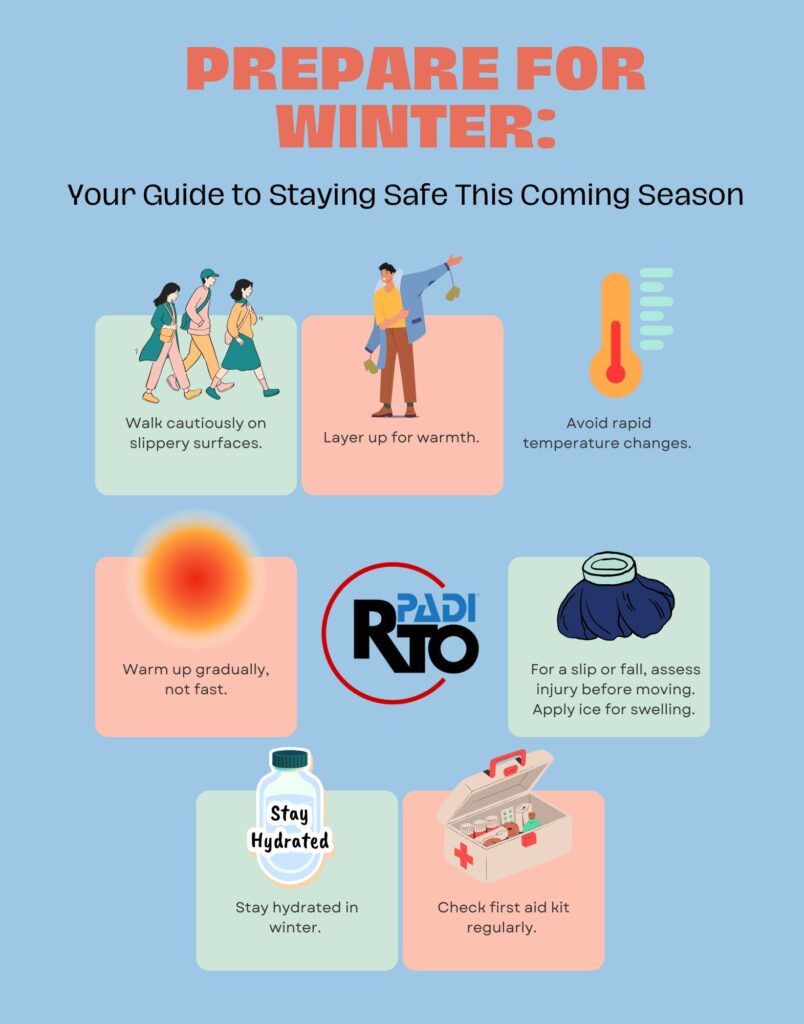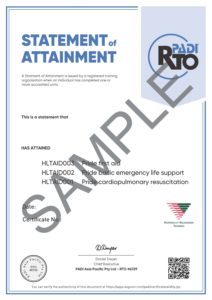As the cooler weather sets in across Australia, it’s time to prepare for the unique challenges that winter brings. While our winter months may not involve snowstorms or heavy snowfalls, the shift in temperatures, wet conditions, and increased risk of slips and falls still require careful attention. As adventure lovers, divers, and outdoor enthusiasts, it’s essential to be prepared for the changes winter can bring, especially when it comes to first aid. Here are some helpful tips for staying safe this winter season, ensuring you’re ready for whatever your adventures bring.
Slippery Conditions: Preventing and Responding to Slips and Falls
Winter in Australia brings a noticeable drop in temperature, and even though snow may not be a concern, wet weather and dew on early mornings create slippery surfaces. Whether you’re heading to the beach, on a hike, or diving in cooler waters, be aware of potential hazards like wet rocks, mossy surfaces, or the morning frost that can make paths and terrain slippery.
Prevention Tips:
- Always wear appropriate footwear with good grip, especially when navigating rocky or uneven terrain.
- Stay cautious of wet or damp surfaces, and walk at a steady pace with your feet firmly planted.
- If you’re hiking, consider using trekking poles for added stability on slippery ground.
If a slip does occur, the impact could result in sprains, fractures, or other injuries. In these instances, knowing what to do until help arrives can make all the difference.
First Aid for Slips and Falls:
- Assess the Injury: Check if the injured person can move without pain. If they are unable to move or there is significant swelling, call for professional medical help immediately.
- Control Bleeding: If the fall results in cuts or abrasions, apply pressure to control bleeding with a clean cloth or bandage.
- Immobilize the Injury: For suspected fractures or sprains, gently immobilize the injured area with any available material, ensuring it is kept still to prevent further damage.
- Apply Ice: For swelling or bruising, apply ice wrapped in a cloth to the injury for 20-minute intervals to reduce swelling.
Changing Temperatures: Managing Temperature Extremes
While the Australian winter is far from the freezing conditions of northern climates, temperatures can still dip significantly, especially in the mornings and evenings. Cold exposure can lead to hypothermia or frostbite if precautions aren’t taken. Likewise, sudden temperature changes from indoor warmth to outdoor cold can put extra strain on the body.
Preventing Cold-related Illnesses:
- Layering Up: Use lightweight, moisture-wicking clothing as your base layer, and add insulating layers like fleece or down jackets. This way, you can regulate your body temperature and avoid overheating or getting too cold.
- Stay Hydrated: Dehydration is often overlooked in cooler months, but it can still affect your energy and performance. Drink water regularly, especially before and after physical activity.
- Avoid Rapid Temperature Changes: Gradually adjust to the cold by layering and not rushing into cold environments too quickly. This can help your body acclimatize more effectively.
If you or someone you’re with shows signs of cold stress, like shivering, confusion, or numbness, it’s important to take action quickly.
- Move to a Warmer Environment: Get the person to a sheltered area away from the cold.
- Warm Up Gradually: Apply warm, dry clothing and use blankets or heat packs on the body’s core (torso, chest) rather than extremities to warm up the body.
- Monitor: If the person’s condition worsens, or if they lose consciousness, seek immediate medical assistance.
Be Prepared with PADI RTO
Winter brings new challenges for those who love the outdoors or diving. By following PADI RTO’s winter first aid tips, you can reduce risks and stay confident in your adventures. Whether you’re diving, hiking, or exploring, preparation is key.
Before you head out, check your first aid kit and consider refreshing your knowledge through a certified course. It’s the best way to stay ready for any situation.

Tags: Diving, First Aid, Nationally Recognised Training, PADI, PADI RTO, Provide First Aid, RTO, RTO Trainer, Training, VET

